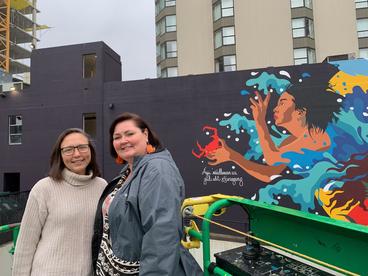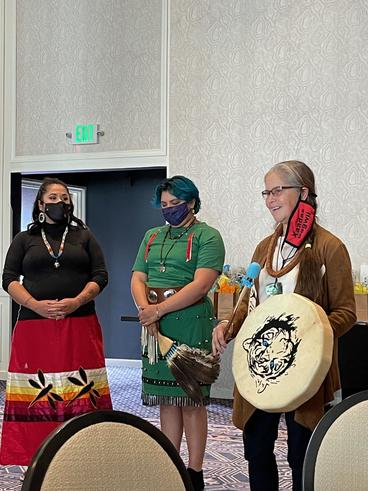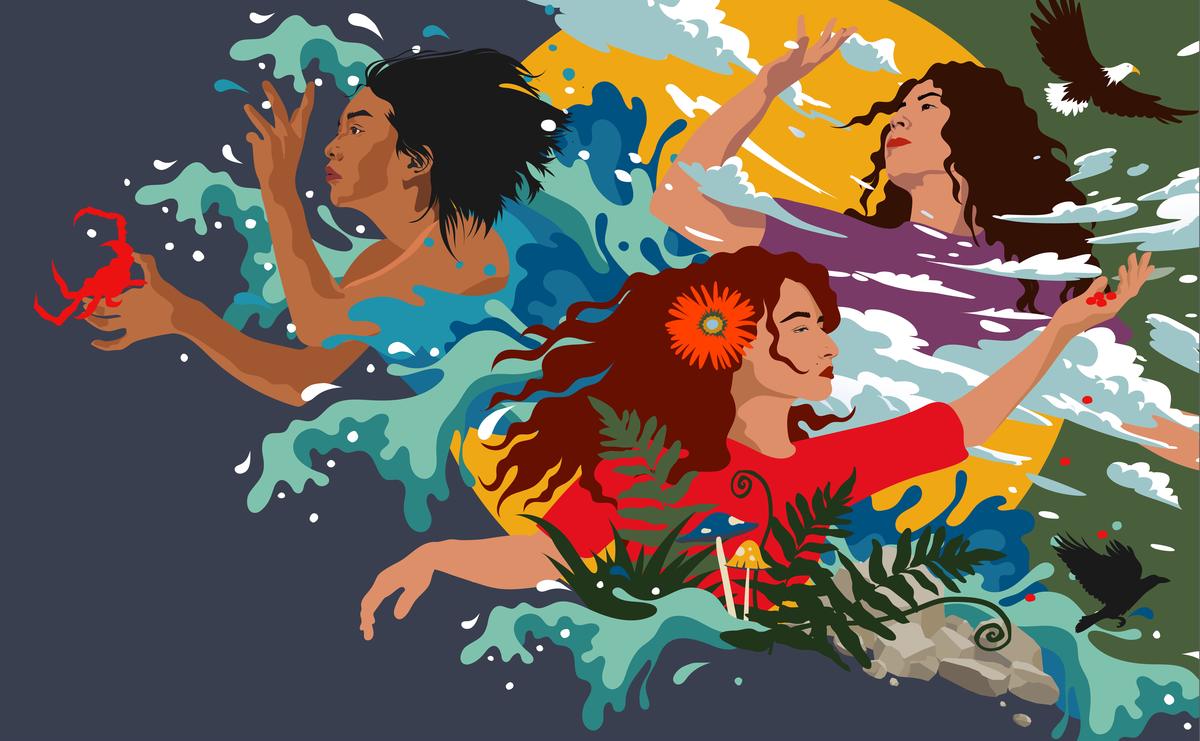On September 12, 2021, Dr. Wendy F. K’ah Skaahluwaa Todd (Smythe) (Alaska Native Haida) (American Indian Studies and Earth and Environmental Sciences) and UMD students Arianna Northbird (Ojibwe) and Teague Ozhaawaashkwa Miigwan Goodsky (Ojibwe) were present in Seattle, Washington for a ceremonial blessing of “Everything Depends on Everything Else,” a mural created by internationally recognized artist and former neuroscientist Amanda Phingbodhipakkiya and inspired by Todd’s background as a Haida woman working in science.

The mural depicts three diverse Haida women, the three elements of air, water, and earth, and the common Haida phrase, “Áajii ‘wáadluwaan uu gud ahl Ḵíiwaagang,” meaning “Everything is connected.” The mural is the first time the Haida language has been publicly displayed; to put some of the Haida spirit into the art, Haida artists Chessaly Towne, Seri Sims, and Lisa Ka’illjuus Lang painted the phrase. Todd appreciates how the public artwork honors an Indigenous knowledge system without exception.
Todd’s piece is part of the mural series, “Findings,” Phingbodhipakkiya began creating in 2020 in places across the U.S. to celebrate women who have advanced science. A mutual friend, Lisa White (University of California Museum of Paleontology), connected the artist with Todd while Phingbodhipakkia was working in San Francisco and experienced trouble finding diverse women scientists for her upcoming mural.
After two 3-hour interviews, Todd shared her body of work from the past fifteen years. In reviewing the materials, Phingbodhipakkia noticed when Todd talked about traditional knowledge, she often referenced air, land, and water as well as the Haida’s matriarchal society and cycles of knowledge—themes that became inspiration for the mural.
Phingbodhipakkia then drafted her vision for the mural and shared it with Todd, who asked for only a few changes, such as making sure each woman had different eye, hair, and skin colors to ensure the mural was representative of all Haida women and conveyed the value of their community in Todd’s success.

Ultimately, Todd was surprised and pleased with the mural. “The Haida people only use red, black, and white in their traditional artwork”, so when Todd saw the piece, she thought, “‘OH! We’re colorful.’ It was interesting to see how Amanda understood Haida people after researching us.” Additionally, the artist had woven in references to Todd’s past, such as a depiction of her childhood friend in one of the women, fish eggs as an allusion to Todd’s membership in the Xáadas (Haida) Nation of the Sdast’as clan, a raven and eagle representing the two matriarchal lines of the Haida people, and rocks for her work with metamorphic green schist.
Phingbodhipakkia had asked Todd for images of Haida regalia, but the artist didn’t end up incorporating it into the mural because she didn’t want to be extractive of native culture when she’s not native. Todd appreciated how much respect, consideration, and awareness Phingbodhipakkia displayed while working with another culture.
Todd obtained a grant from Sealaska Corporation to bring elders and community members from Alaska to the ceremony in Seattle. Around thirty people from Alaska and other parts of the country were present at the ceremony to perform a song and dance blessing. While Seattle was simply the next place on Phingbodhipakkia’s mural list, it coincidentally has a large Haida community, and a group of nearby Fond du Lac Ojibwe community members also joined in the ceremony and shared in the food, prayer, and stories.
Teague Goodsky reflected, “The Haida women are so powerful, and they lead their culture in so many ways….The Haida women, who this mural was dedicated to, seemed to have no fear. They were bold, they were loud, and they were so completely happy to be together that they gave strength to everyone in the room. The way they laugh (and the things they laugh about) is wildly infectious.
“The most memorable moment for me was when we were all invited to participate in ‘The Friendship Song.’ We were taught the basic gestures and words, but the Haida women led. You couldn’t help but feel loved and connected in that moment.”
Todd hoped the elders, who were part of the boarding school generation and associate education with pain, would see the mural as a sign of respect for their knowledge systems and help them heal from their past. She also wanted the youth to connect with elders, see the knowledge systems displayed in a positive way, and empower them to keep moving knowledge forward. Todd stated, “The Native youth often hide in academia because it’s uncomfortable to navigate two knowledge systems, but I hope they realize our knowledge systems are valid and they are proud.”
The mural will be displayed for five years, and Todd hopes everyone will see a different way of communicating science to the public and Indigenous viewers will take heart in it: “Someone from the village can do it! You can make an impact.”
